Can You Fly Over North Pole? Yes, flying over the North Pole is a common practice for many airlines today, offering shorter routes and reduced fuel consumption; this is a great way to save time and money. Flyermedia.net explores this fascinating aspect of modern aviation, shedding light on transpolar flights, historical milestones, and the unique challenges and advantages they present. Discover the captivating world of Arctic aviation with Flyermedia.net, where we bring you the latest insights into aviation technology and polar navigation, and aviation safety.
1. The Reality of Transpolar Flights
Have you ever wondered if planes actually fly over the North Pole? Absolutely. Many modern airliners regularly traverse what’s sometimes called “Santa’s Shortcut” to minimize flight duration and decrease fuel expenditures. For example, a flight from New York to Hong Kong takes a more direct route over the Arctic rather than following lines of latitude. This route leverages the Earth’s curvature, significantly reducing both time and fuel costs.
1.1. The Atlas Deception
Why does it seem unusual? The common two-dimensional representation of Earth on an atlas often misleads us. We tend to visualize international travel from a west-to-east perspective. Hong Kong might appear east of New York on a flat map, but the quickest route involves flying over the North Pole.
1.2. The Benefits of “Santa’s Shortcut”
What are the real advantages? Airlines utilizing transpolar routes experience considerable savings. These flights trim flight hours, leading to lower fuel consumption and reduced operational costs. Passengers also benefit from shorter travel times, making long-haul flights more bearable.
2. A Historical Perspective on Arctic Aviation
When did this all start? The concept of flying over the North Pole has evolved from a daring dream to a routine practice. Early attempts were fraught with challenges, highlighting the courage and determination of aviation pioneers.
2.1. The Early Explorers
Who were the first to attempt this daring feat? The allure of the North Pole has captivated explorers for centuries, and aviators were no exception. One notable figure is Salomon Andree, a Swedish engineer, who attempted to navigate to the North Pole via hot air balloon in 1897. Andree and his crew launched from Svalbard but crashed shortly after, leading to a tragic end.
2.2. Richard Byrd’s Achievement
When was the North Pole first successfully flown over? In 1926, U.S. Navy Lt. Commander Richard Byrd successfully flew over the North Pole in a Fokker Trimotor, departing from and returning to Svalbard within 15 hours. This marked a significant milestone in aviation history.
2.3. Valery Chalov’s Transpolar Flight
What was the first true transpolar flight? In 1937, Valery Chalov completed the first true transpolar flight, flying from Moscow to Vancouver, Washington, in 63 hours, covering nearly 5,500 miles. This achievement demonstrated the potential of long-distance Arctic flights.
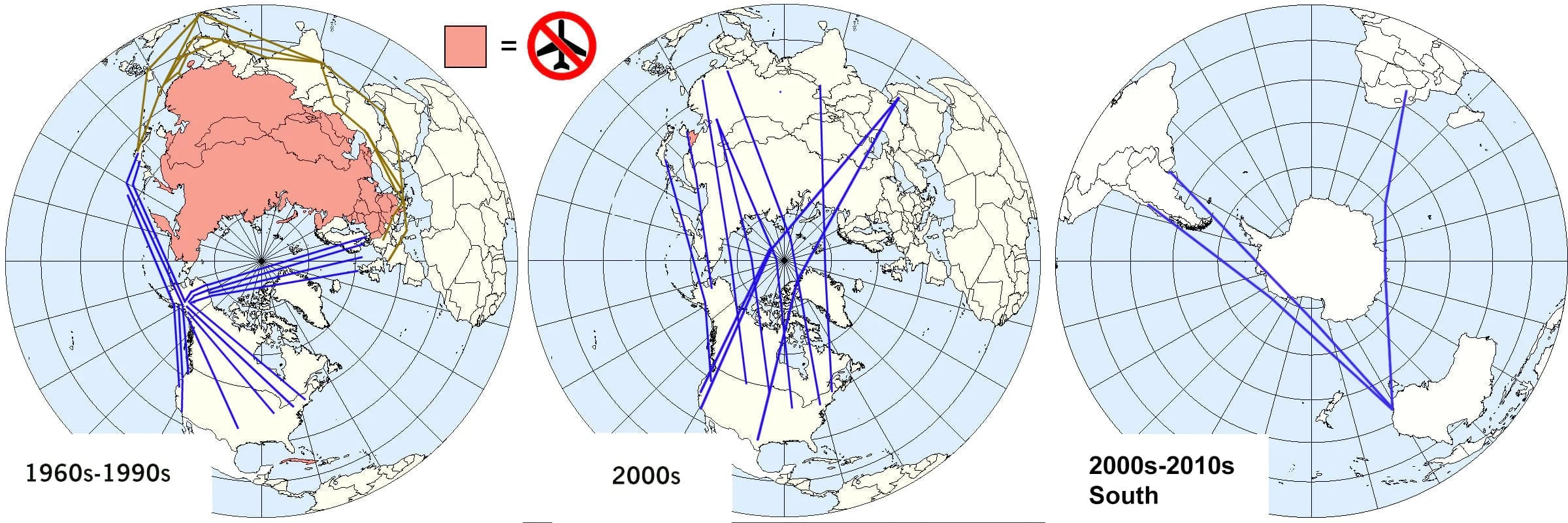 Valery Chalov's Transpolar Flight
Valery Chalov's Transpolar Flight
3. The Dawn of Commercial Transpolar Flights
When did commercial airlines start flying over the North Pole? By the mid-20th century, advancements in technology and navigation made commercial transpolar flights feasible.
3.1. Overcoming Navigational Challenges
What made it so difficult initially? Early aviators faced significant challenges, including the considerable distance between the geographic and magnetic North Poles, which could cause compass inaccuracies. Improved maps and navigational technologies were crucial in overcoming these issues.
3.2. SAS’s Pioneering Flight
Who was the first airline to offer commercial flights over the North Pole? In 1952, Scandinavian carrier SAS conducted an experimental flight from Los Angeles to Copenhagen using a Douglas DC-6. Following approval from American aviation authorities, SAS began regularly flying passengers over the pole between these cities in 1954.
 SAS's Pioneering Flight
SAS's Pioneering Flight
3.3. Cold War Limitations
How did the Cold War affect these flights? The Cold War imposed restrictions on air space over the Soviet Union, limiting transpolar flights. Additionally, the U.S. initially restricted these routes to aircraft with more than two engines due to safety concerns.
4. Modern Arctic Flight: Enhancements and Efficiencies
What has changed in recent years? Modern aircraft and updated regulations have made transpolar flights more accessible and efficient.
4.1. Advancements in Aircraft Technology
How have planes improved? Modern aircraft are equipped with advanced navigation systems, improved engine reliability, and better fuel efficiency. These advancements have made transpolar routes safer and more economical.
4.2. Regulatory Changes
What regulatory changes have occurred? In 2011, the U.S. relaxed regulations on the distance twin-engine planes can operate from the nearest airport in emergencies, opening up the North Pole to more aircraft.
4.3. Time and Enjoyment
How much time can be saved? Flying over the North Pole between Hong Kong and New York can cut flight time by up to two hours. Many travelers also report a more enjoyable experience, with pilots often descending to lower altitudes over the Arctic for better views.
4.4. Surprising Routes
Which routes utilize transpolar flights? Even routes that might not seem obviously northern, such as Emirates Airlines’ flight from Los Angeles to Dubai, utilize transpolar routes to optimize flight time and fuel consumption.
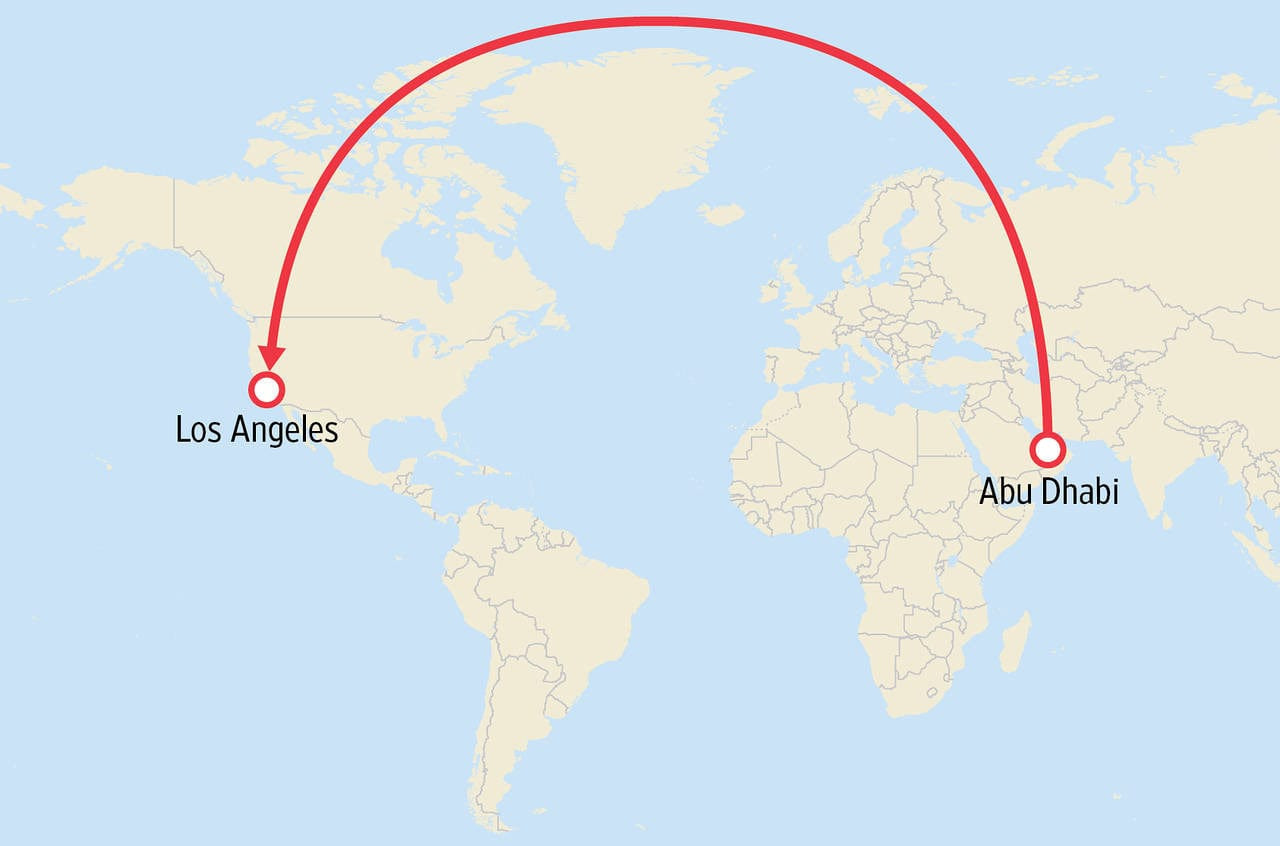 Emirates Airlines' Routes
Emirates Airlines' Routes
5. The Invisible Risk: Solar Radiation
Are there any risks associated with these flights? Yes, solar radiation poses a potential risk in polar navigation.
5.1. Understanding Solar Radiation
Why is solar radiation a concern? The Earth’s magnetic field typically deflects most solar radiation. However, at the poles, the magnetic field converges, allowing solar radiation to penetrate the atmosphere more easily.
5.2. Passenger Safety
Is it dangerous for passengers? While a single polar flight does not exceed safe radiation levels for passengers, repeated exposure could pose a risk to flight crews. Airline pilots may be exposed to more radiation than workers in nuclear power plants.
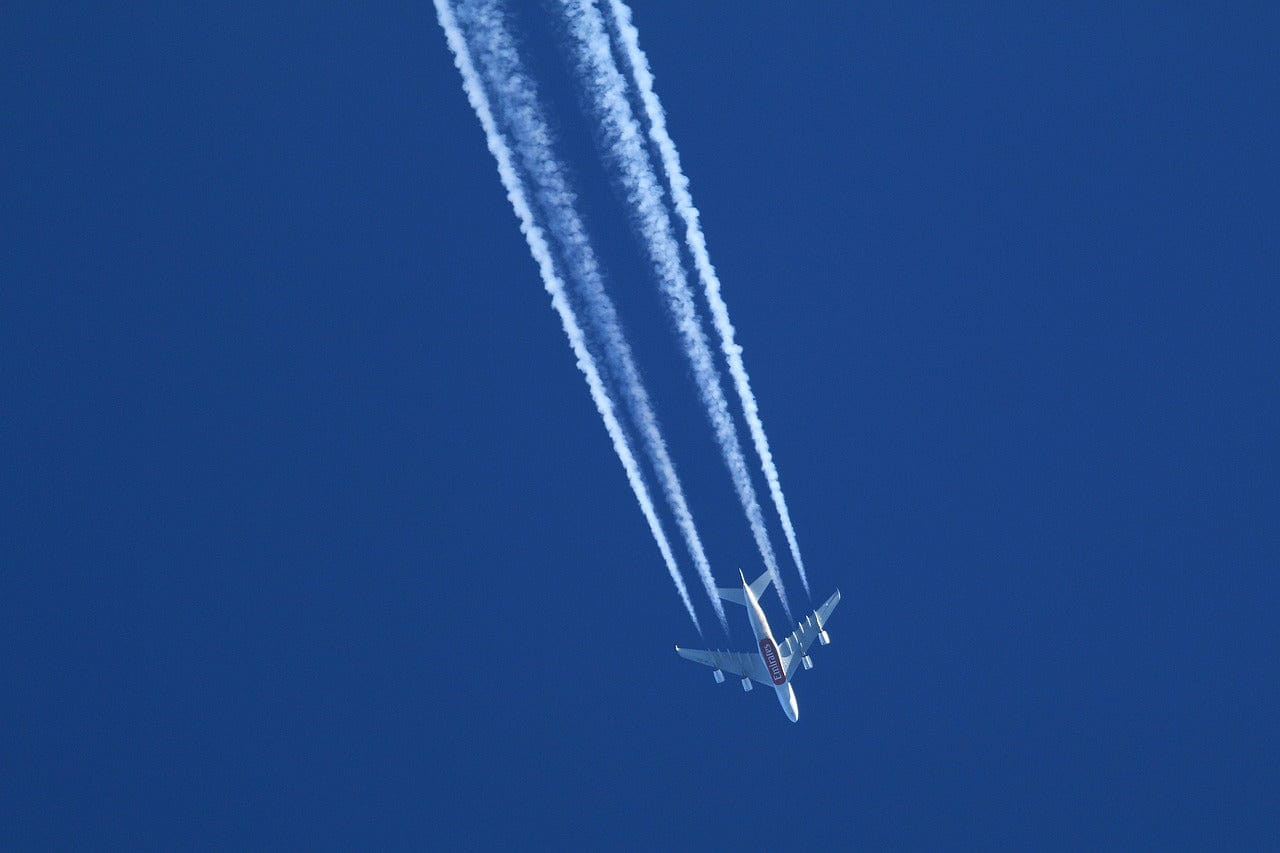 Understanding Solar Radiation
Understanding Solar Radiation
6. What About Antarctica?
Why don’t we hear about flights over Antarctica? While flights over the North Pole are common, flights over Antarctica are rare.
6.1. Richard Byrd’s Antarctic Flight
When was the first flight over the South Pole? In 1929, Richard Byrd flew from the Ross Ice Shelf to the South Pole and back, marking the first flight of its kind.
6.2. The Polecat Crew
What was the first flight around both poles? In 1966, a Boeing 707 Jet flew around both poles, starting and ending in Honolulu, covering 26,275 miles in 62.5 hours with stops in London, Lisbon, Buenos Aires, and Christchurch.
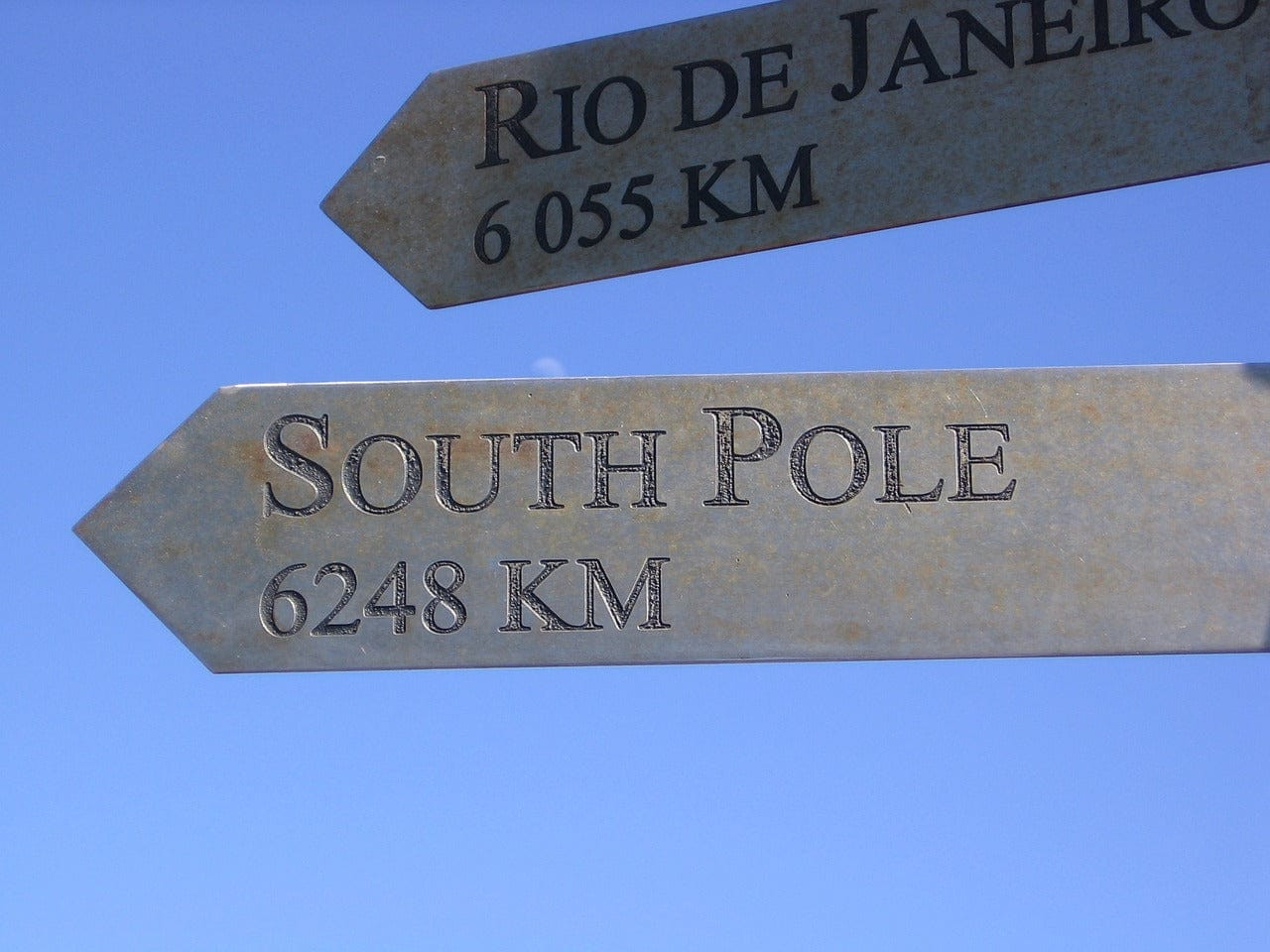 The Polecat Crew
The Polecat Crew
7. Why So Little Antarctic Traffic?
What makes Antarctica less suitable for commercial flights? Several factors contribute to the scarcity of flights over Antarctica.
7.1. Population and Land Mass
How does the Southern Hemisphere differ? The Southern Hemisphere has a smaller population and less land mass compared to the Northern Hemisphere, resulting in fewer flights and less demand for trans-Antarctic routes.
7.2. Safety Concerns
Is it safe to fly over Antarctica? Antarctica is considered more dangerous than the Arctic for commercial airlines due to fewer diversion airports and treacherous weather conditions.
7.3. Air New Zealand Flight 901
What tragic event highlighted these dangers? In 1979, Air New Zealand Flight 901 crashed into Mt. Erebus, killing 257 passengers and crew, underscoring the risks of Antarctic flights.
7.4. Sightseeing Flights
Are there any flights over Antarctica? Some privately chartered planes offer sightseeing flights over Antarctica from Australia.
8. The Challenges of Flying Over North and South America
What makes these routes complex? Despite numerous airports and traffic routes, flying over North and South America presents unique challenges.
8.1. Air Traffic
What’s the main issue? The high volume of daily air traffic across these continents can lead to congestion and delays.
8.2. Safety Regulations
Are safety regulations consistent? Inconsistent air safety rules, particularly in Latin America, can cause airlines to seek alternative routes.
8.3. Diversion Airports
Why are diversion airports important? Limited availability of accessible diversion airports in South America can force planes to travel over the ocean, close enough to these airports, to avoid potential traffic issues.
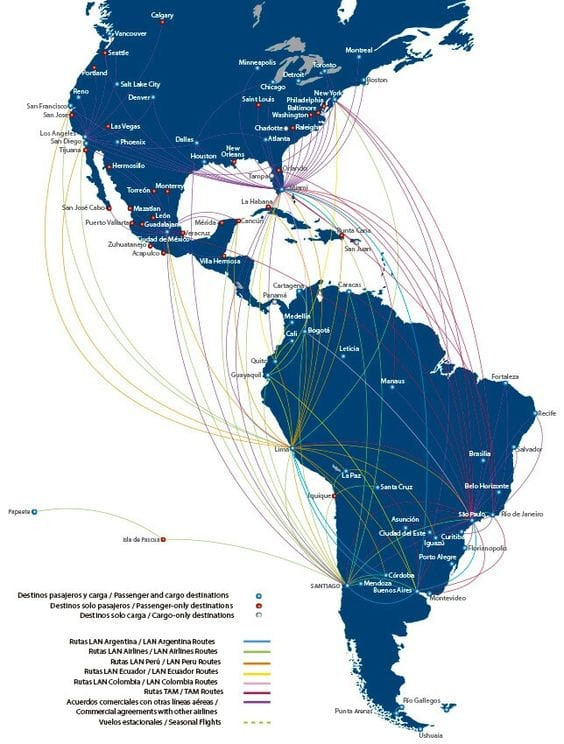 The Challenges of Flying Over North and South America
The Challenges of Flying Over North and South America
9. The Science Behind Transpolar Flights
What scientific principles make these flights possible? Understanding the Earth’s geometry and magnetic field is crucial for navigating transpolar routes.
9.1. Great Circle Routes
What is a great circle route? Transpolar flights utilize great circle routes, which are the shortest distance between two points on a sphere. By flying along these routes, airlines can save time and fuel.
9.2. Magnetic Navigation
How do pilots navigate near the poles? Pilots rely on advanced navigation systems, including GPS and inertial navigation, to mitigate the challenges posed by magnetic field variations near the poles.
10. The Environmental Impact of Transpolar Flights
How do these flights affect the environment? While transpolar flights can reduce fuel consumption, they also raise concerns about emissions and their impact on the Arctic environment.
10.1. Fuel Efficiency
Do transpolar flights reduce emissions? By shortening flight times, transpolar routes can reduce overall fuel consumption and emissions compared to traditional routes.
10.2. Environmental Concerns
What are the potential environmental impacts? The Arctic environment is particularly sensitive to pollution, and increased air traffic can contribute to issues such as air and noise pollution, impacting local ecosystems.
11. The Future of Transpolar Flights
What innovations and changes can we expect in the future? The future of transpolar flights will likely be shaped by technological advancements, regulatory changes, and a growing emphasis on sustainability.
11.1. Technological Innovations
How will technology improve transpolar flights? Innovations such as more efficient aircraft, advanced navigation systems, and alternative fuels could further enhance the safety and efficiency of transpolar routes.
11.2. Sustainable Practices
What steps can be taken to reduce environmental impact? Airlines are exploring sustainable practices, such as using biofuels and implementing more efficient flight operations, to minimize the environmental impact of transpolar flights.
12. Navigating Transpolar Routes: A Pilot’s Perspective
What does it take to pilot a plane over the North Pole? Flying over the North Pole requires specialized training and expertise.
12.1. Pilot Training
What training is required? Pilots undergo specific training to understand the unique challenges of polar navigation, including weather conditions, communication protocols, and emergency procedures.
12.2. Weather Considerations
How does weather affect these flights? Polar weather can be unpredictable and severe, requiring pilots to be prepared for conditions such as extreme cold, ice, and limited visibility.
13. The Passenger Experience on Transpolar Flights
What is it like to fly over the North Pole as a passenger? For many travelers, flying over the North Pole is a unique and memorable experience.
13.1. Unique Views
What can passengers see? Passengers may have the opportunity to see stunning views of the Arctic landscape, including ice fields, glaciers, and the Northern Lights.
13.2. Potential Turbulence
Are there any discomforts? Passengers should be prepared for potential turbulence, as polar regions can experience unpredictable air currents.
14. The Economic Benefits of Transpolar Flights
How do these flights contribute to the global economy? Transpolar flights play a significant role in facilitating international trade and tourism.
14.1. Trade and Tourism
How do these flights boost the economy? By shortening travel times and reducing costs, transpolar routes facilitate increased trade and tourism between continents.
14.2. Fuel Savings
What are the cost savings? Airlines can achieve substantial fuel savings by utilizing transpolar routes, which can translate to lower ticket prices for passengers.
15. Regulations Governing Transpolar Flights
What rules and guidelines must airlines follow? Transpolar flights are subject to stringent regulations to ensure safety and environmental protection.
15.1. FAA Regulations
What regulations are in place in the U.S.? The FAA (Federal Aviation Administration) sets strict standards for aircraft maintenance, pilot training, and operational procedures for flights over remote areas such as the Arctic.
15.2. International Agreements
Are there international agreements? International agreements and collaborations among aviation authorities help ensure consistent safety standards for transpolar flights.
16. Emergency Procedures for Transpolar Flights
What happens if something goes wrong? Airlines have detailed emergency procedures in place for transpolar flights.
16.1. Diversion Airports
Where can planes land in an emergency? Designated diversion airports along transpolar routes are equipped to handle emergency landings and provide necessary support.
16.2. Communication Protocols
How do pilots communicate in remote areas? Robust communication systems, including satellite communication, ensure that pilots can maintain contact with air traffic control and emergency services in remote areas.
17. The Cultural Significance of Transpolar Flights
How have these flights impacted our understanding of the world? Transpolar flights have contributed to a greater understanding of the Arctic and Antarctic regions and their importance to the global ecosystem.
17.1. Exploration and Discovery
How do these flights aid research? Transpolar flights have enabled scientists and researchers to study the polar regions more effectively, leading to valuable insights into climate change and other environmental issues.
17.2. Global Connectivity
How do these flights connect us? By bridging continents, transpolar flights have fostered greater cultural exchange and understanding among people from different parts of the world.
18. Transpolar Flights and National Security
How do these flights impact national security? Transpolar flights have implications for national security, including surveillance and defense.
18.1. Surveillance
How are these flights used for surveillance? Government agencies may utilize transpolar flights for surveillance and monitoring purposes in the Arctic region.
18.2. Defense
How do these flights aid defense? The Arctic region is of strategic importance for defense, and transpolar flights can play a role in military operations and reconnaissance.
19. The Impact of Climate Change on Transpolar Flights
How is climate change affecting these routes? Climate change is altering the Arctic environment, with potential implications for transpolar flights.
19.1. Melting Ice
How is melting ice affecting routes? Melting sea ice could open up new navigation routes in the Arctic, but it could also create hazards such as unstable ice conditions and increased storm activity.
19.2. Changing Weather Patterns
How are weather patterns changing? Climate change is causing shifts in weather patterns, which could affect the safety and reliability of transpolar flights.
20. The Future of Antarctic Flights
Will we see more flights over Antarctica in the future? The future of flights over Antarctica is uncertain, but technological advancements and increased demand could lead to more commercial flights in the coming years.
20.1. Potential Routes
What routes could be viable? Potential routes could connect Australia and South America or South Africa, catering to tourists interested in experiencing the Antarctic landscape.
20.2. Technological Advancements
What advancements are needed? Advancements in aircraft technology, navigation systems, and weather forecasting will be crucial for making Antarctic flights safer and more feasible.
21. Common Misconceptions About Transpolar Flights
What are some common myths? Several misconceptions surround transpolar flights, which can lead to confusion and misinformation.
21.1. Radiation Levels
Are radiation levels dangerous? While there is some exposure to solar radiation on transpolar flights, the levels are generally not dangerous for passengers.
21.2. Extreme Turbulence
Is turbulence always severe? Turbulence can occur on transpolar flights, but it is not always severe and can often be avoided by adjusting altitude or route.
22. Careers Related to Transpolar Flights
What career opportunities exist? The growth of transpolar flights has created various career opportunities in aviation.
22.1. Pilots
What skills are needed to be a pilot? Pilots need specialized training in polar navigation, weather conditions, and emergency procedures.
22.2. Air Traffic Controllers
What skills are needed to be an air traffic controller? Air traffic controllers require expertise in managing air traffic in remote and challenging environments.
22.3. Aviation Maintenance Technicians
What skills are needed to be an aviation maintenance technician? Aviation maintenance technicians must ensure that aircraft are properly maintained and equipped for transpolar flights.
23. The Role of Aviation Safety Organizations
How do organizations ensure safety? Aviation safety organizations play a crucial role in promoting safe practices and procedures for transpolar flights.
23.1. IATA
What does IATA do? IATA (International Air Transport Association) sets standards for aviation safety and works to improve industry practices.
23.2. FAA
What does the FAA do? The FAA regulates aviation in the United States and sets standards for aircraft maintenance, pilot training, and operational procedures.
24. The Importance of International Cooperation
Why is cooperation important? International cooperation is essential for ensuring the safety and efficiency of transpolar flights.
24.1. Airspace Management
How is airspace managed? International agreements facilitate the management of airspace over the Arctic and Antarctic regions.
24.2. Search and Rescue Operations
How are search and rescue operations conducted? Coordinated search and rescue operations are critical in case of emergencies on transpolar flights.
25. The Psychological Impact of Transpolar Flights
What are the psychological effects? Transpolar flights can have psychological effects on both passengers and crew.
25.1. Cabin Fever
What is cabin fever? Cabin fever can occur on long flights due to confined spaces and limited social interaction.
25.2. Stress Management
How can stress be managed? Passengers and crew can manage stress by staying active, engaging in social activities, and utilizing relaxation techniques.
26. Weather Forecasting for Transpolar Flights
How is weather predicted? Accurate weather forecasting is crucial for ensuring the safety and efficiency of transpolar flights.
26.1. Satellite Data
How is satellite data used? Satellite data provides valuable information about weather patterns, ice conditions, and other environmental factors.
26.2. Forecasting Models
How are forecasting models used? Advanced forecasting models help meteorologists predict weather conditions along transpolar routes.
27. The Economic Viability of Antarctic Tourism
Could tourism be viable in Antarctica? The economic viability of Antarctic tourism depends on various factors, including infrastructure development, environmental regulations, and tourist demand.
27.1. Infrastructure Challenges
What are the infrastructure challenges? Building and maintaining infrastructure in Antarctica is costly and challenging due to harsh environmental conditions.
27.2. Environmental Regulations
What environmental regulations are in place? Strict environmental regulations are in place to protect the Antarctic environment from the impacts of tourism.
28. Historical Incidents and Lessons Learned
What lessons have been learned? Historical incidents involving transpolar flights have provided valuable lessons for improving safety and operational procedures.
28.1. Air New Zealand Flight 901
What were the lessons learned from this flight? The crash of Air New Zealand Flight 901 highlighted the importance of clear communication, accurate navigation, and thorough weather forecasting.
28.2. Other Incidents
What lessons have been learned from other incidents? Other incidents have led to improvements in aircraft design, emergency procedures, and pilot training.
29. Future Technologies for Transpolar Navigation
What technologies are being developed? Future technologies could revolutionize transpolar navigation and improve safety and efficiency.
29.1. Autonomous Navigation
What is autonomous navigation? Autonomous navigation systems could reduce the workload on pilots and improve accuracy in remote areas.
29.2. Enhanced Communication Systems
What are enhanced communication systems? Enhanced communication systems could provide more reliable connectivity in remote areas, allowing for better coordination and emergency response.
30. The Impact of Transpolar Flights on Global Relations
How do these flights affect global relations? Transpolar flights can foster greater cooperation and understanding among nations.
30.1. Cooperation
How is cooperation fostered? Transpolar flights require cooperation among nations to manage airspace, coordinate search and rescue operations, and ensure safety.
30.2. Trade Agreements
How do trade agreements impact flights? Trade agreements can facilitate the growth of transpolar flights by reducing barriers to international travel and trade.
Polar Flight FAQs
Can Planes Fly Over North Pole?
Yes, planes can fly over the North Pole, and many flights from North America to Europe and Asia do so to cut flight time and save fuel.
Is Flying Over Antarctica Illegal?
No, flying over Antarctica is not illegal; however, few commercial airliners do it due to safety concerns.
Why Do Planes Not Fly Over the South Pole?
Planes don’t typically fly over the South Pole due to the especially treacherous weather and the limited availability of diversion airports in case of emergency. Additionally, the southern hemisphere is less populated, resulting in fewer flights and less demand for polar routes.
Do you dream of soaring through the skies and experiencing the thrill of aviation firsthand? Visit flyermedia.net to discover comprehensive resources on flight training, aviation news, and career opportunities in the USA. Whether you’re an aspiring pilot, aviation enthusiast, or industry professional, flyermedia.net is your go-to source for all things aviation. Explore our website today and take the first step towards realizing your aviation dreams. For more information, visit us at 600 S Clyde Morris Blvd, Daytona Beach, FL 32114, United States, or call +1 (386) 226-6000.